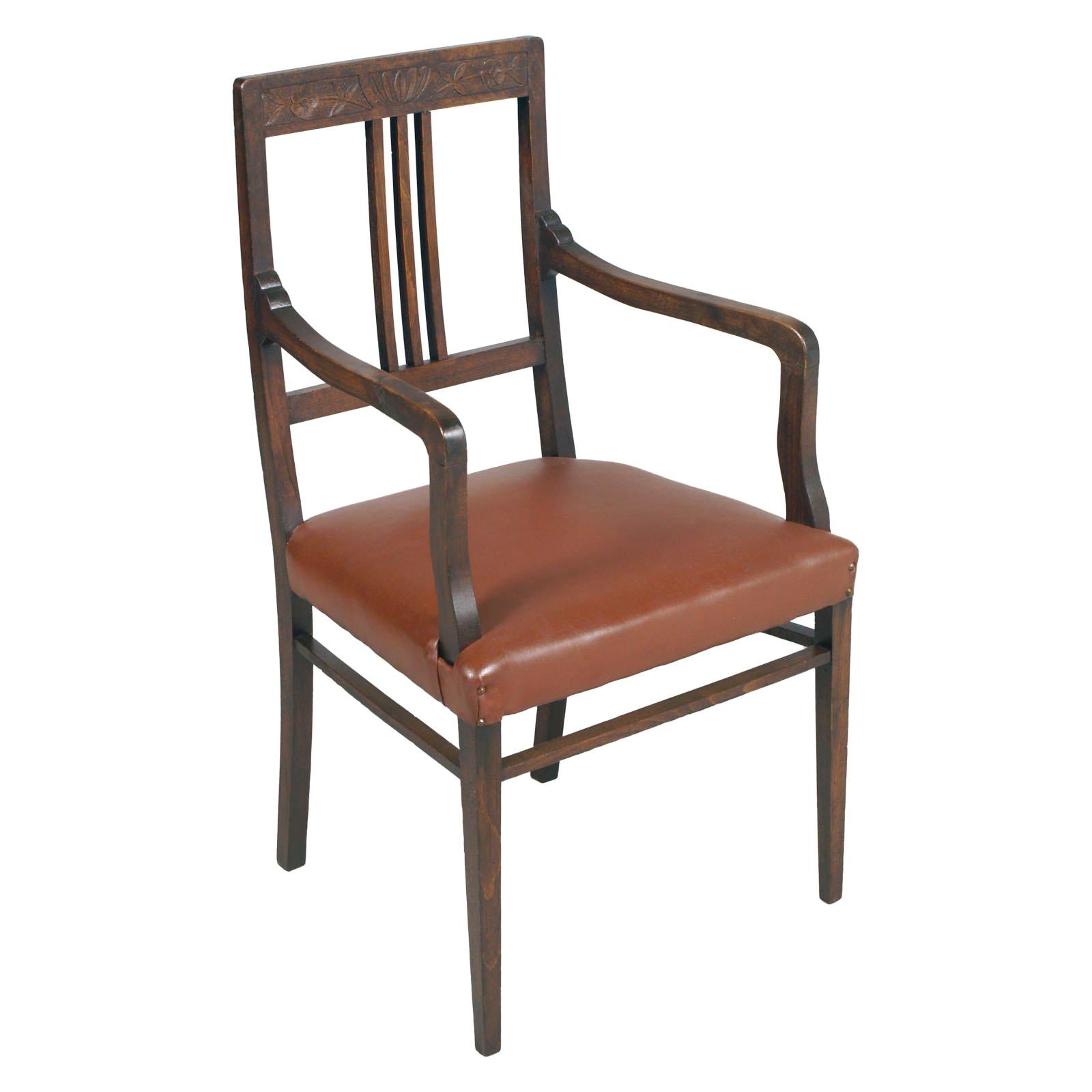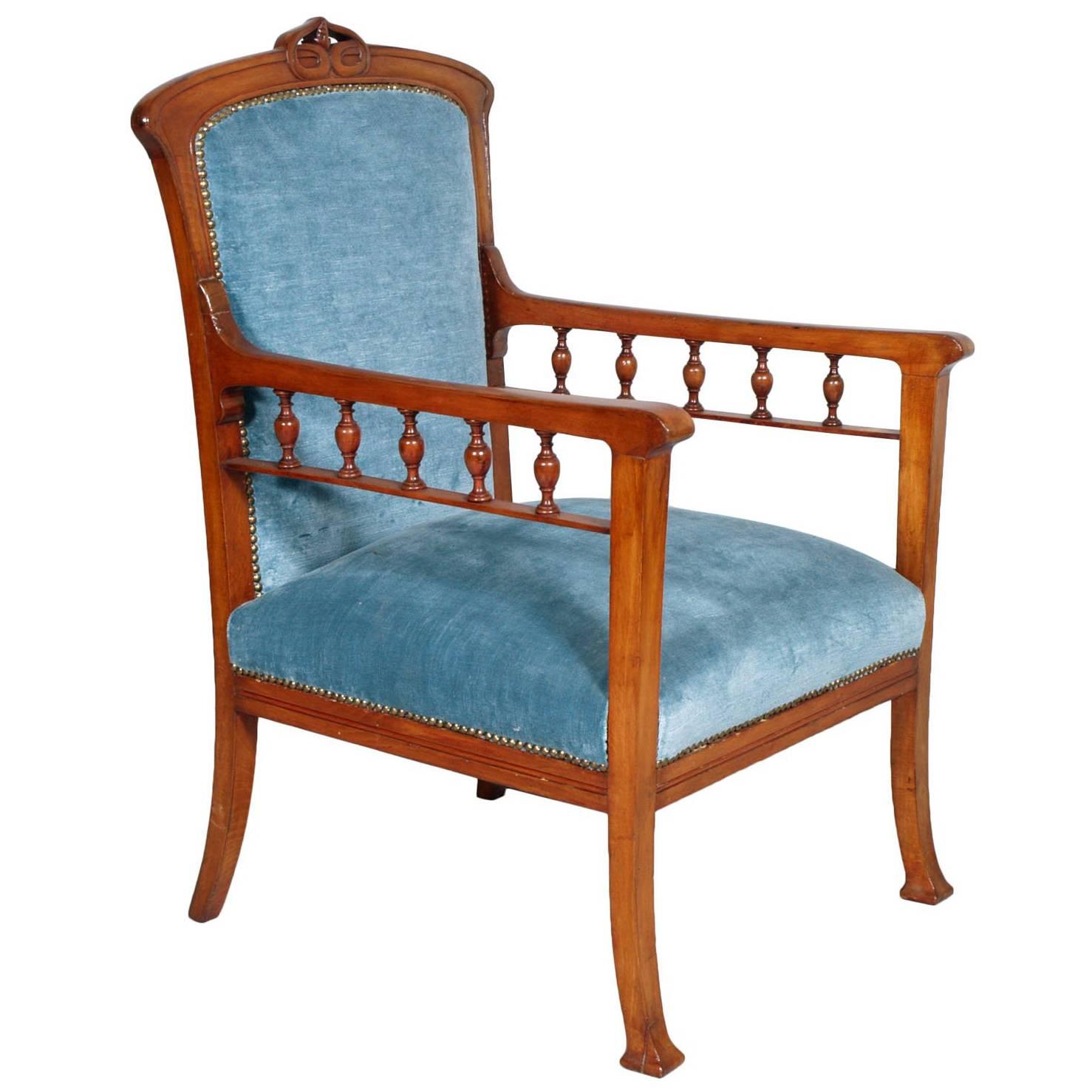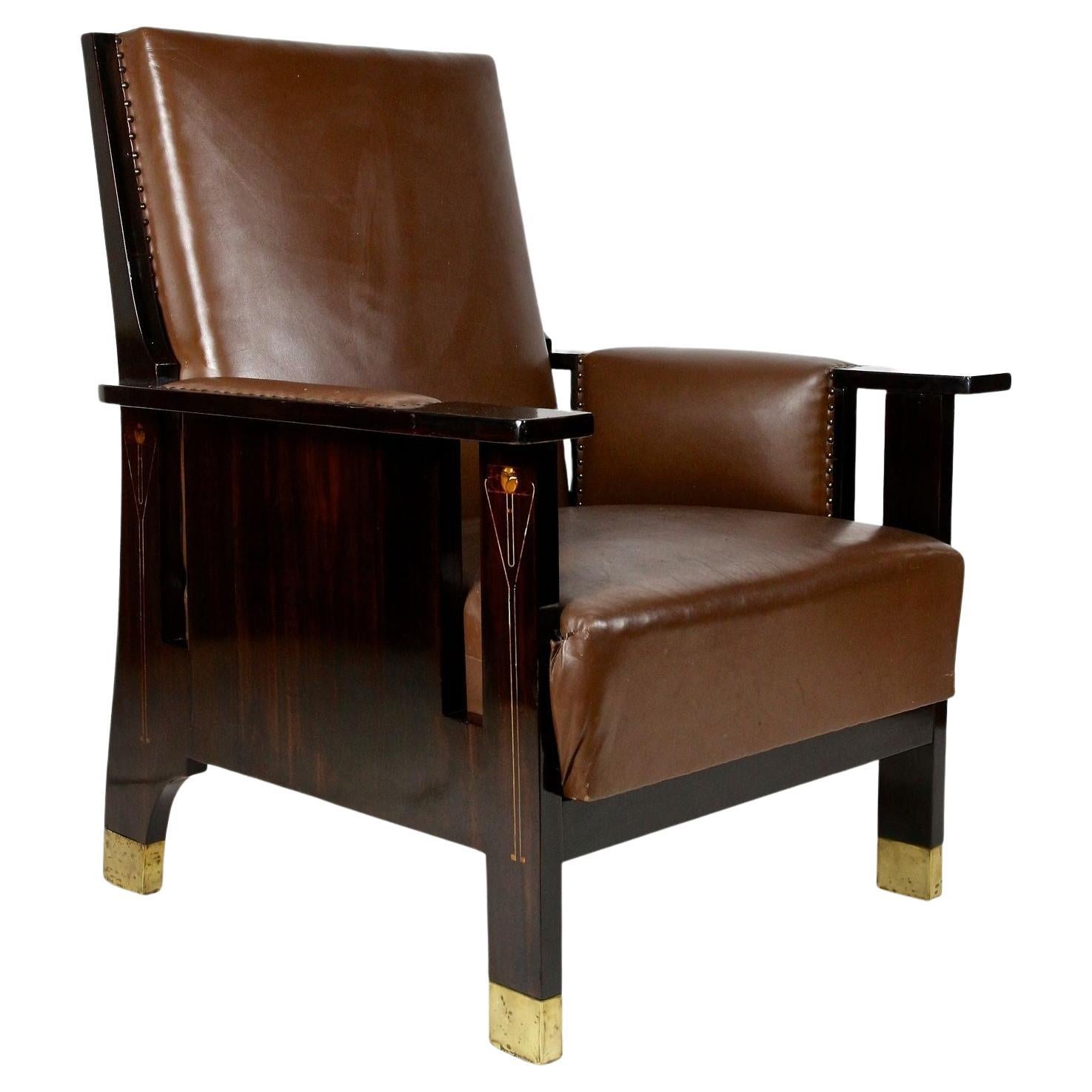Items Similar to Pair of Art Nouveau Large Armchairs in Walnut
Want more images or videos?
Request additional images or videos from the seller
1 of 10
Pair of Art Nouveau Large Armchairs in Walnut
About the Item
Incredible Art Nouveau price of 2 Sofa Armchairs
Material: Wood, reupholstered with springs and elastic band (as it was in the old days) If you have any questions we are at your disposal.
The name "Art Nouveau" in French means "new art". It is also known as Jugendstil in Germany. In contrast, in Vienna and in Italy, "Liberty style". The Art Nouveau designs used curvilinear sinuous asymmetrical lines, often based on plant forms. and feminine silhouettes. The style was used in architecture, interior design, glass, jewelry, sculpture, painting, posters and illustration. Introduced new materials such as opals and semi-precious stones Art Nouveau had its greatest impetus in the 1900 Universal Exhibition in Paris. After that, it spread throughout Europe, USA and Australia In Paris you can see the entries in metro are of Hector Guimard and Émile Gallé. Some artists are: Gustav Klimt, Charles Rennie Mackintosh, Alphonse Mucha, René Lalique, Antoni Gaudí and Louis Comfort Tiffany. Victor Horta had a decisive impact on architecture in Belgium. Each of them interpreted it their way. Why are there so many antiques in Argentina? In the 1880 – 1940 there was a grate wave of immigration encouraged by the periods of war that were taking place. 1st World War took place between 1914 and 1918 2nd World War took place between 1939 and 1945 The immigrants options were New York or Buenos Aires. Tickets were cheap and in Buenos Aires they were welcomed with open arms, as it was a country where everything was still to be done. Argentina was the country of new opportunities, labour was needed and religious freedom was assured, in many cases the of the family travel first until they were settled and then the rest of the family members join them. In the immigrant museum “Ellis Island Immigrant Building” in New York you can se the promotional posters of the boats that would take them to a new life. Between the years 1895 and 1896, Argentina had the highest DGP (gross domestic product) per capita in the world according to the Maddison Historical Statistics index, this situation arose due to the large amount of food being exported to European countries, which were at war. The Argentinean ships left the port of Buenos Aires with food, but they returned with furniture, clothes and construction elements, (it´s common to see this the old buildings of the historic neighbourhood of San Telmo, the beams with the inscription “Made in England)”, as well as many markets that were built in Buenos Aires, such us the San Telmo Market, whose structure was brought by ship and afterwards assembled in 900 Defensa Street. With the great influence of European immigrants living in the country, the children of the upper classes travelled to study in France, resulting in the inauguration of “La Maison Argentinienne”, on 27th of June 1928, in the international city of Paris, which hosted many Argentinians that were studying in Frace. It´s the fourth house to be built after France, Canada and Belgium, being the first Spanish-speaking one. Still in place today (17 Bd Jourdan, 75014, Paris, France). Many of the children of these wealthy families who attended international art exhibitions, museums and art courses abroad, took a keen interest in the European style. This is why Buenos Aires was at the time referred as “The Paris of South America”. Between the years 1890 and 1920 more than a hundred Palaces were built on Alvear Avenue the most exclusive avenue in Buenos Aires. Today some of these palaces have been transformed into museums, hotels and embassies. In the year 1936, the Kavanagh building was inaugurated, it was the tallest reinforced concrete building in South America. During 1994 the American Society of Civil Engineers distinguished it as an “international engineering milestone”, and it´s now considered a World Heritage of Modern Architecture. At the time was common to hire foreign architects such as Le Corbusier, who visited Buenos Aires/Argentina in 1929 and in 1948 he drew up the blueprints for a house built in La Plata City (which was declared a World Heritage Site). In 1947, the Hungarian architect Marcelo Breuer designed “Parador Ariston” in the seaside city of Mar del Plata. After an Argentinean student at Harvard University convinced him to come to Argentina. He worked on an urban development project in the Casa Amarilla, area of La Boca. The Ukrainian architect, Vladimiro Acosta, arrives in Argentina in 1928 and worked as an architect until que moved to Brazil. Antonio Bonet, a Spanish architect who worked with Le Corbusier in Paris, arrives in Argentina in 1937, where he carried out several architectural works and in 1938 designs the well-known BFK chair. Andres Kálnay, of Hungarian origin, made around 120 architectural masterpieces, among which the former Munich brewery stands out, he even made the furniture’s design. The German architect, Walter Gropius, director of the Bauhaus, lived in Argentina, where he wrote articles for “Sur” magazine and founded in Buenos Aires, an architectural firm with Franz Möller, who was also an architect, where he built two houses. At the same time several famous designers decided to immigrate to Argentina, among them we can find the well-known French designer, Jean-Michel Frank, who arrived in the country in 1940 and also worked for the Rockefeller family. Special pieces were made, which were sold exclusively in the country, such as the well-known German company “WMF”, who sold their products by catalogue, which were chosen by the ladies of high society in the list of wedding gifts, as well as the pieces designed by Christofle. The Swiss sculptor Alberto Giacometti, made special pieces for Argentinean mansions. In 1904 the first Jansen branch outside Paris was established in Buenos Aires, as the Argentinean clientele demanded a large amount of furniture, from the end of the 19th century to the mid-20th century. In 1970, the brand Rigolleau Argentina made pieces authorised by Lalique. The brands Maple and Thompson also set up shop in the country. The French plastic artist, Marcel Duchamp moved to Argentina in 1918-1919. Glass signed Gallé, Charder, Leverre, Schneider, Muller and other French firms. They were bought in flower shops and were given to ladies with beautiful floral arrangements. Some furniture manufacturers travelled to international fairs and bough the patterns to produce the furniture in Argentina, such as the furniture firm Englander and Bonta, who bought the patterns ins Italy. It is worth mentioning that in Argentina we have the largest community of Italians outside of Italy, as it is estimated that 70 percent of the inhabitants have at least one Italian descendant, followed by Spanish immigrants. The most Important furniture stores in Argentina: Comte is founded in 1934 (under the direct management of Jean Michel Frank in 1940). Nordiska (Swedish company established in 1934). Churba in 1960, a company that brought foreign designers to present their furniture in the country: Denmark: (Arne Jacobsen, Finn Juhl, Bender Madsen, Ejner Larsen, Poul Kjaerholm, Hans Wegner) Sweden: (Hans Agne Jakobsson, Gustavsberg) United States: (Herman Miller) Finland: (Lisa Johansson, Folke Arstrom, Tapio Wirkkala, Alvar Aalto, Timo Sarpaneva) Swedish Factory: (Orrefors) Italy: (Littala, Vico Magistretti, Emma Gismondi, Gae Aulenti, Angelo Mangiarotti, Elio Martinelli, Gianna Celada, Angelo Mangiarotti, Mario Bellini, Carlo Scarpa) Finland: (Olivia Toikka) Plata Lappas (Lappas Silver): a goldsmith shop founded in 1887 in Argentina by Alcibiades Lappas of Greek origin. In 2019, in Argentina took place “the Art Deco world congress”, in which we participated as hosts invited by Geo Darder, founder of the Copperbridge – Foundation, in which prominent people from all over the world attended to learn about Art Deco in Argentina. Argentina currently has more than 100 Art Deco buildings and another 90 Art Nouveau buildings throughout the city of Buenos Aires. Argentina is a country that has not been involved in many wars, which is why it has been a refuge for works of art and antiques from different periods of time, unlike European countries. That is way many collectors, museums and antique dealers from all over the world visit it, you should not miss the opportunity to visit this great country.
- Dimensions:Height: 43.31 in (110 cm)Width: 42.13 in (107 cm)Depth: 23.63 in (60 cm)Seat Height: 19.69 in (50 cm)
- Sold As:Set of 2
- Style:Art Nouveau (Of the Period)
- Materials and Techniques:
- Place of Origin:
- Period:
- Date of Manufacture:1900
- Condition:Refinished. Wear consistent with age and use.
- Seller Location:Miami, FL
- Reference Number:1stDibs: LU1726239409932
About the Seller
4.7
Platinum Seller
These expertly vetted sellers are 1stDibs' most experienced sellers and are rated highest by our customers.
Established in 1995
1stDibs seller since 2015
1,053 sales on 1stDibs
Typical response time: 1 hour
- ShippingRetrieving quote...Ships From: Paterna, Spain
- Return PolicyA return for this item may be initiated within 3 days of delivery.
More From This SellerView All
- French Dining Armchairs In Leather And Walnut, 1950s, Set Of 4Located in Miami, FLSet of 4-piece walnut wood armchairs and vintage leather seat. Around the 1950s. The characteristic of the chairs is that they come with their original black leather upholstery, sli...Category
Mid-20th Century French Art Deco Club Chairs
MaterialsLeather, Walnut
- Pair of Swedish Empire ArmchairsLocated in Miami, FLIn mahogany and on carved feet with brass castors, the scroll arms with carved anthemion leaves at the top. In very good condition.Category
Antique 1860s Empire Armchairs
MaterialsWood
- Pair of Art Deco Club Armchairs with Blue Ink Damask VelvetLocated in Miami, FLPair of Art Deco club armchairs with blue ink damask velvet Very comfortable armchairs with turned walnut armchairs It has two carved legs an...Category
Mid-20th Century European Art Deco Lounge Chairs
MaterialsVelvet, Walnut
- 19th Set of Six Spanish Low Armchairs in Carved Walnut and Red Velvet UpholsteryLocated in Miami, FL19th century set of six Spanish low armchairs in carved walnut and red velvet upholstery decorated with yellow fringes. Arm Height: 24.6inCategory
Antique Late 19th Century Spanish Spanish Colonial Club Chairs
MaterialsVelvet, Walnut
- Spanish Armchairs in Carved Walnut and Red Velvet Upholstery '46units'Located in Miami, FL19th century Spanish low armchairs in carved walnut and red velvet upholstery decorated with yellow fringes. Very very comfortable and resistant’s It come from an Spanish Casino 4...Category
Antique Late 19th Century Spanish Spanish Colonial Club Chairs
MaterialsVelvet, Walnut
- Mid Century Spanish Armchairs in Wood, Set of 2Located in Miami, FLThe shape of this pair of classic Mid Century armchairs is simply fabulous with its beautiful wooden legs on the front, arms and back and seat. The back and seat of this armchair are...Category
Mid-20th Century French Art Deco Club Chairs
MaterialsUpholstery, Walnut
You May Also Like
- Pair of Art Nouveau Mahogany Armchairs, 1920sLocated in Virum, DKDanish cabinetmaker: A pair of Art Nouveau mahogany armchairs with curved arms and front legs, upholstered with green fabric, 1920s.Category
Vintage 1920s Danish Art Nouveau Armchairs
MaterialsMahogany
- 1890s French Armchairs Art Nouveau, Hand Carved Walnut, Restored & Wax PolishedLocated in Vigonza, PaduaLate 19th century beautiful and refined Provençal armchairs, Art Nouveau, hand carved walnut, restored and wax polished. Measures cm: H 46/99, W 52, D 52.Category
Antique Late 19th Century French Art Nouveau Armchairs
MaterialsLeather, Walnut
- Italian 1910s Art Nouveau Armchair Hand Carved walnut , Eugenio Quarti mannerLocated in Vigonza, PaduaCode: FL25 Elegant original Italian Art Nouveau armchair in solid blond walnut with, new Velvet Upholstered, The style is that of Eugenio Quarti (1867-1929) - Italian Furniture & Ca...Category
Vintage 1910s Italian Art Nouveau Armchairs
MaterialsVelvet, Walnut
- 1900s Antique Art Nouveau Armchair Bedroom Armchair, Belle ÉpoqueLocated in Vigonza, Padua1910s antique Art Nouveau Belle Époque armchair. This gorgeous silk satin chair of the Belle Époque comes from the noble family “Della Torre di Rezzonico”. This branch of the family...Category
Antique Early 1900s Italian Art Nouveau Club Chairs
MaterialsSilk, Walnut
- Pair of Art Deco Style Armchairs in Walnut and Piano Black with Brass DetailsLocated in Greven, DEThis pair of Art Deco style armchairs in walnut and black piano lacquer with brass details and fabric by Andrew Martin (Mossop Natural) have been handcrafted to the very highest qual...Category
2010s German Art Deco Armchairs
MaterialsBrass
- Art Nouveau 20th Century Palisander Armchair, Mother Of Pearl, Austria ca 1905Located in Lichtenberg, ATAbsolute extraordinary, one of kind Art Nouveau palisander armchair from the very early 20th century in Vienna around 1905. This impressive antique armchair is not just a "normal" ar...Category
Early 20th Century Austrian Art Nouveau Armchairs
MaterialsBrass





